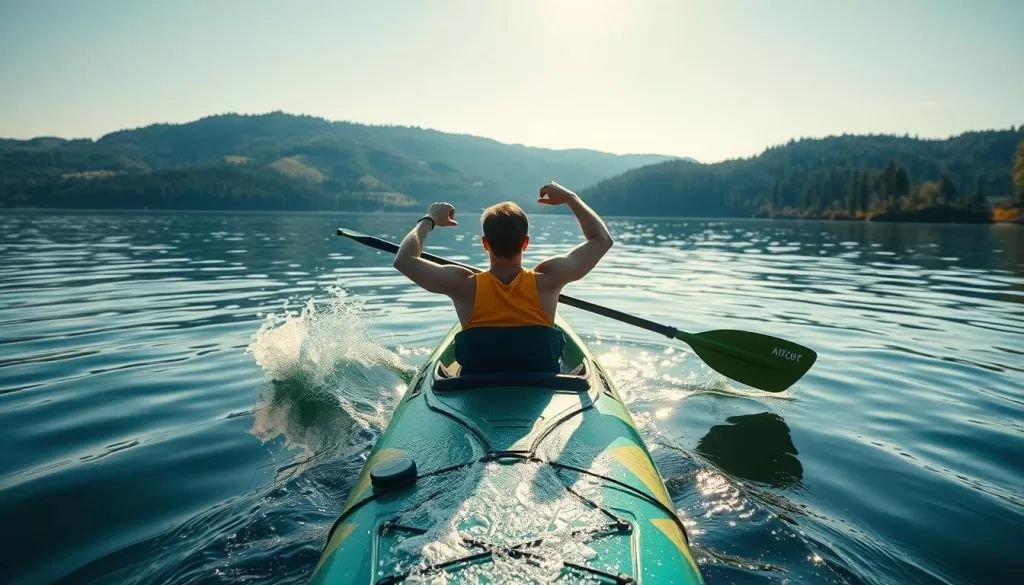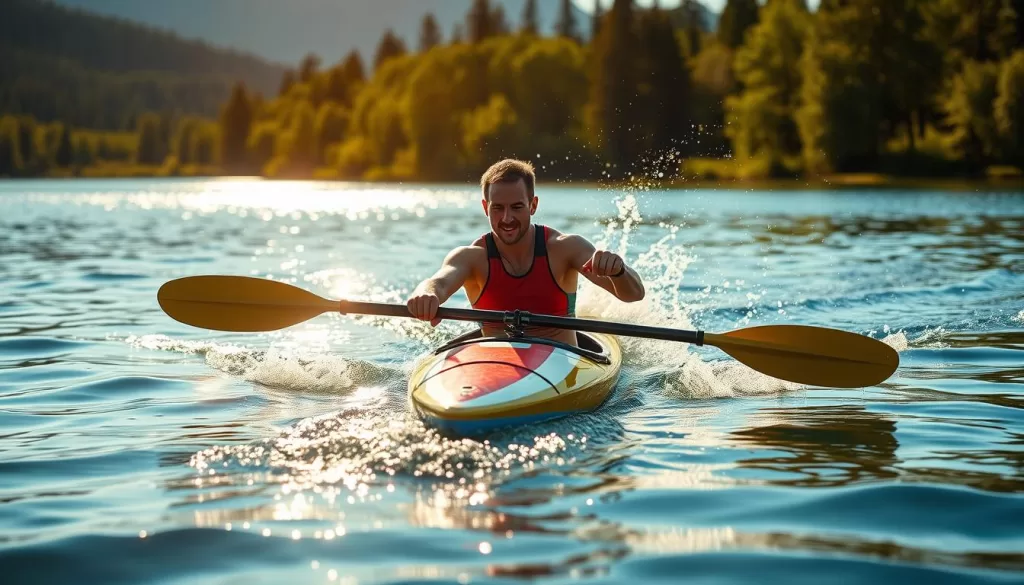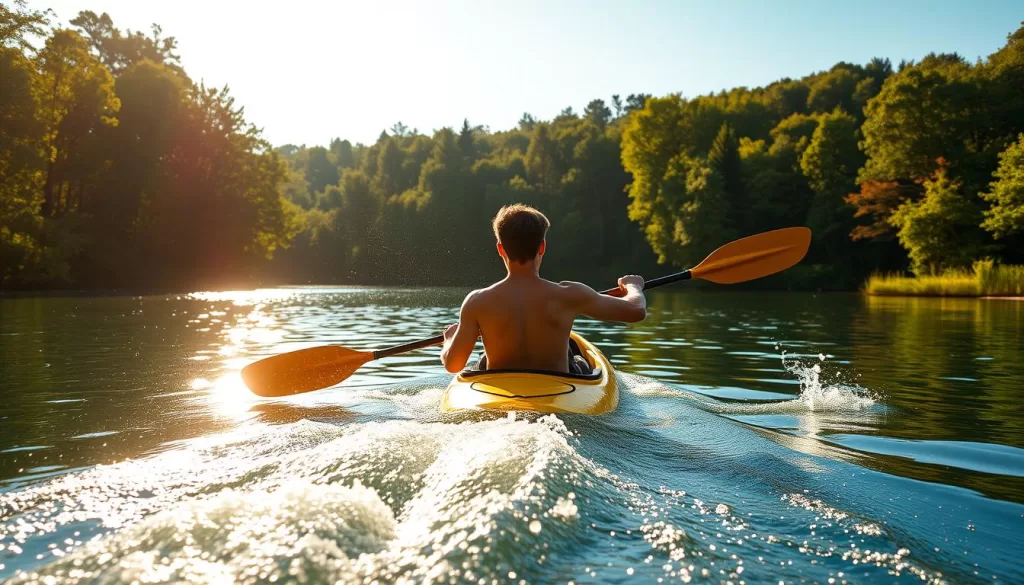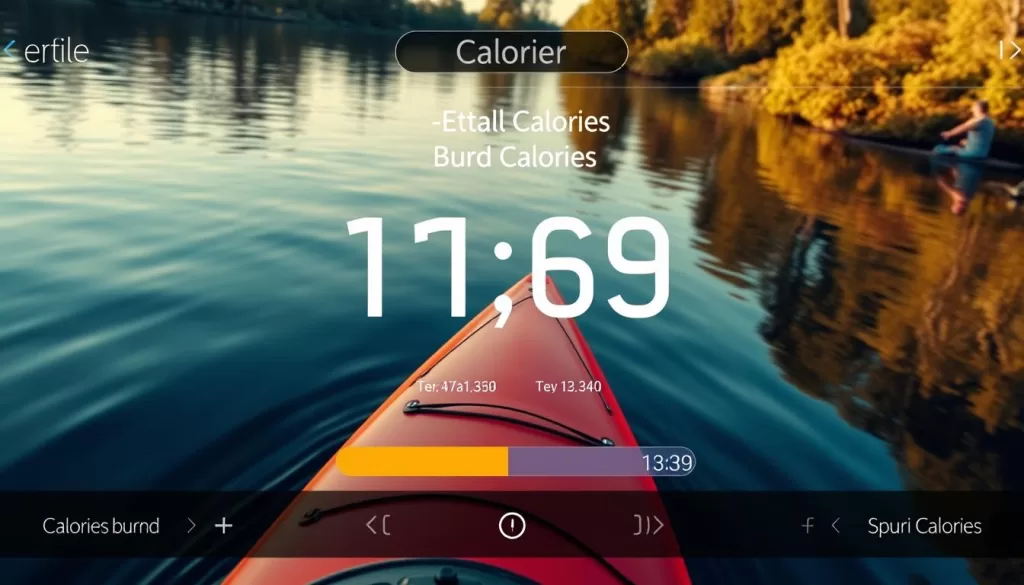Did you know that someone weighing about 200 pounds can burn up to 454 calories in just one hour of kayaking? That’s a great way to have fun while staying fit! Kayaking is more than just a fun activity on the water. It’s a workout that boosts yoWorkoutur health and helps with weight loss.
On average, paddlers can burn 283 to 475 calories per hour. This depends on their weight and how hard they paddle. Kayaking not only lets you enjoy beautiful views but also helps you reach your fitness goals.

Key Takeaways
- Kayaking can burn between 283 to 475 calories per hour based on weight and intensity.
- A 200-pound paddler can burn approximately 454 calories in an hour.
- This activity engages multiple muscle groups, strengthening the upper body and core.
- Regular kayaking supports both cardiovascular health and muscle development.
- Being on the water can enhance your mood through the release of endorphins.
- 1 Understanding the Basics of Kayaking as Exercise
- 2 Calories Burned Kayaking: An Overview
- 3 Comparing Calories Burned in Different Kayaking Intensities
- 4 Key Factors Affecting Caloric Burn in Kayaking
- 5 How Water Conditions Affect Calories Burned
- 6 Metabolic Rate and Calories Burned Kayaking
- 7 Full-Body Workout Benefits of Kayaking
- 8 Kayaking for Weight Loss Efforts
- 9 A Common Misconception: Is Kayaking Just Leisurely Fun?
- 10 Getting Started with Kayaking as Part of Your Fitness Routine
- 11 Advantages of Kayaking Beyond Caloric Burn
- 12 Tracking Your Caloric Burn: Using a Calorie Calculator
- 13 Conclusion
- 14 FAQ
- 15 Source Links
Understanding the Basics of Kayaking as Exercise
Kayaking is a great way to boost your physical health and fitness. It’s a full-body workout that strengthens many muscles and improves heart health. Kayaking is fun and engaging, making it a favorite for those who enjoy exercise.
What Makes Kayaking a Workout?
Kayaking works your upper, core, and lower body. It builds endurance and strength over time. The main muscles used are:
- Abdominals
- Latissimus dorsi (lats)
- Biceps
- Forearms
- Shoulders
- Back muscles
Regular kayaking can make your muscles stronger, especially your lats. This improves your fitness. Kayaking also burns calories, making it great for losing weight and staying fit.
Types of Kayaking Activities
There are many kayaking activities for all levels and interests. Each one offers unique challenges and benefits:
- Recreational Kayaking: Great for beginners, it’s done on calm waters like lakes and slow rivers.
- Sea Kayaking: Paddles in ocean waters, offering the excitement of waves and currents.
- Whitewater Kayaking: Navigates rough waters, burning more calories due to the challenge.
- Standup Paddleboarding: An alternative to traditional kayaking, it can burn up to 500 calories per hour.
Trying different kayaking activities keeps your workouts interesting and fun. It helps you stay motivated and excited about your fitness journey.
Calories Burned Kayaking: An Overview

Kayaking is a fun way to stay fit. It burns calories based on your weight, how hard you paddle, and how long you kayak. On average, people burn 375 to 475 calories per hour. This number can change based on how hard you try and your fitness level.
Average Caloric Expenditure for Various Body Weights
Your weight affects how many calories you burn while kayaking. Here’s a table showing calories burned per hour for different weights during moderate kayaking:
| Body Weight (lbs) | Calories Burned per Hour |
|---|---|
| 140 | 334 |
| 150 | 358 |
| 180 | 428 |
| 200 | 476 |
| 125 | 283 |
Factors Influencing Calorie Burn
Several things affect how many calories you burn while kayaking:
- Kayak Intensity: Paddling harder burns more calories.
- Duration: Kayaking longer means burning more calories.
- Technique: Using the right paddling technique burns more calories.
- Environmental Conditions: Kayaking in tough waters makes it harder.
- Resistance: Paddling with extra weight or against currents burns more calories.
Comparing Calories Burned in Different Kayaking Intensities
The intensity of your kayaking session greatly affects how many calories you burn. Knowing the difference between moderate and vigorous effort helps you reach your fitness goals. Terrain also plays a big role in how many calories you burn. Let’s look at how these factors impact your calorie burn.
Moderate Effort vs. Vigorous Effort
Kayaking at different intensities burns different amounts of calories. For example, a 200-pound person can burn about 476 calories per hour at a moderate pace. On the other hand, vigorous activities like whitewater rafting can burn 300 to 500 calories per hour. This depends on how intense the rapids are.
Impact of Terrain on Caloric Expenditure
The terrain you paddle in also affects how many calories you burn. Paddling against currents or in rough waters requires more energy, leading to higher calorie burn. Beginners might burn more calories as they learn proper technique. Advanced kayakers, on the other hand, can paddle more efficiently.
Here’s a table showing the calories burned based on weight and effort:
| Weight (lbs) | Moderate Effort (calories/hour) | Vigorous Effort (calories/hour) |
|---|---|---|
| 125 | 283 | Approx. 400 |
| 155 | 283 | Approx. 450 |
| 200 | 476 | Approx. 500 |
Your choice of kayaking intensity changes not just calorie burn but also workout benefits. Exploring different terrains makes kayaking fun and boosts your exercise’s effectiveness.
Key Factors Affecting Caloric Burn in Kayaking

There are several key factors that affect how many calories you burn while kayaking. Your weight and body composition are big factors. They determine how many calories you’ll burn during your paddle.
The length of your kayaking session also matters. Longer sessions mean you burn more calories. Knowing these factors helps you plan your kayaking to reach your fitness goals.
Weight and Body Composition
Your weight and body composition affect how many calories you burn. Heavier people burn more calories while kayaking. For example, someone who weighs about 300 pounds can burn around 716 calories in an hour of moderate paddling.
On the other hand, a 120-pound kayaker might burn about 286 calories in the same time. Males generally burn more calories than females because they have more muscle and less body fat. Younger kayakers also burn more calories than older ones because they have more muscle and less fat.
Duration of the Kayaking Session
The length of your kayaking session is another important factor. Longer sessions mean you burn more calories. For instance, paddling at a moderate to vigorous pace can burn 350 to 550 calories per hour.
Doctors often suggest doing at least 30 minutes of moderate exercise each day. This improves your fitness and helps you burn more calories during your kayaking trips.
| Body Weight | Calories Burned (Moderate Paddling) | Calories Burned (Vigorous Paddling) |
|---|---|---|
| 120 lbs | 286 | 716 |
| 150 lbs | 358 | 745 |
| 200 lbs | 476 | 1,051 |
| 300 lbs | 716 | 1,790 |
How Water Conditions Affect Calories Burned
Water conditions greatly affect how many calories you burn while kayaking. Knowing how these factors impact your energy use can make kayaking more fun and effective.
Paddling in Calm Waters
Paddling in calm waters is usually easier and burns fewer calories. You might burn 250-350 calories per hour, depending on your weight and the kayak’s design. Sit-on-top kayaks can burn more calories because they allow for more movement.
This type of paddling is good for everyone, offering a workout that’s easy on your joints but still works many muscles.
Challenges of Whitewater Kayaking
Whitewater kayaking, on the other hand, is much harder and burns more calories. The rough waters require a lot of effort, which can burn 450-550 calories per hour. Paddling against wind or current also increases calorie burn.
Doing this kind of kayaking not only raises your heart rate but also improves your skills and muscle strength.
| Water Condition | Intensity Level | Calories Burned (per hour) |
|---|---|---|
| Calm Waters | Light Paddling | 250-350 |
| Calm Waters | Moderate Paddling | 350-450 |
| Whitewater | Vigorous Paddling | 450-550 |
| Paddling Against Current | High Intensity | Varies Significantly |
Metabolic Rate and Calories Burned Kayaking

Knowing how your metabolic rate affects kayaking can boost your caloric burn. The intensity of your effort, shown in MET values, helps measure energy use. This depends on how hard you paddle.
Understanding MET Values
MET stands for Metabolic Equivalent of Task. It’s a way to measure energy use in different activities. Kayaking’s MET values can change a lot:
- Moderate kayaking: around 5.0 METs
- Vigorous kayaking: can reach 8.0 METs or higher
This change in MET values is key. It shows how many calories you burn each minute while kayaking.
Applying the MET Formula for Caloric Burn Calculation
The caloric burn formula helps you see how many calories you burn while kayaking:
Calories burned per minute = (MET x body weight in Kg x 3.5) ÷ 200
Let’s say you weigh 70 kg and kayak moderately with a MET value of 5.0:
- Calories burned per minute = (5 x 70 x 3.5) ÷ 200 = 12.25 calories
- In an hour, you burn about 735 calories.
By knowing your metabolic rate and MET values, you can better understand how to burn more calories. This makes your kayaking better.
Full-Body Workout Benefits of Kayaking
Kayaking is a full-body workout that engages many muscle groups. It builds strength and improves core stability. This makes it a great choice for those who love fitness.
Muscle Groups Engaged While Kayaking
When you paddle, several muscles work together. These include:
- Arms: Strengthened through continuous paddling.
- Back: Lats and upper back muscles play a crucial role in the rowing motion.
- Core: Essential for stability and balance during kayaking, improving overall core strength.
- Legs: Engaged to stabilize your position in the kayak, especially during turns and maneuvers.
Core Stability and Strength Development
Keeping your core stable is key while kayaking. It helps you navigate better. The paddling motion also strengthens your abdomen.
This improves your performance on the water. It also boosts bone density and balance.
| Intensity Level | Calories Burned per Hour | Engaged Muscle Groups |
|---|---|---|
| Light Paddling | 250-350 | Arms, Core |
| Moderate Paddling | 350-450 | Arms, Back, Core |
| Vigorous Paddling | 450-550 | All major muscle groups |
Kayaking for Weight Loss Efforts

Kayaking is a great way to lose weight. It burns a lot of calories, helping you reach your goals. Knowing how many calories you can burn and how to increase that number will boost your fitness.
How Many Calories Can You Burn in an Hour?
The calories burned while kayaking depend on your weight and how hard you paddle. Here’s a rough guide:
| Body Weight | Calories Burned (Moderate Pace) |
|---|---|
| 120 lbs | 286 calories |
| 155 lbs | 283 calories |
| 200 lbs | 476 calories |
| 300 lbs | 716 calories |
Kayaking in tough waters like whitewater burns even more calories. You could burn 300 to 500 calories per hour. Standup paddle boarding also burns 400 to 500 calories per hour. Mixing up your water activities keeps your weight loss fun.
Tips for Maximizing Caloric Burn
To burn more calories while kayaking, try these tips:
- Vary Your Intensity: Mix in fast paddling to push yourself.
- Longer Sessions: Paddle for longer to burn more calories.
- Choose Varied Terrains: Paddle against currents or in tough waters for more challenge.
- Engage Proper Technique: Use good paddling techniques to work different muscles.
- Kayak with Friends: Kayaking with others means longer trips and more calories burned.
Following these tips will not only help you burn more calories but also make kayaking a fun part of your fitness routine. It’s a great way to stay healthy and active.
A Common Misconception: Is Kayaking Just Leisurely Fun?
Kayaking might look like just a fun activity, but it’s actually intense. It’s a great workout that gets your heart rate up. Many people don’t realize how much of a workout kayaking can be.
The Intensity of Kayaking Workouts
The intensity of kayaking depends on how fast you go and the water conditions. You can burn up to 400 calories in just one hour. This shows kayaking is more than just fun.
Doing lots of paddling helps build your aerobic fitness. It also helps with weight loss. For example, a three-hour kayaking session can burn up to 1200 calories.
Kayaking as a Form of Cardio Exercise
Kayaking works out many muscles at once. It improves your heart health and builds strength. It’s different from high-impact sports because it’s easier on your joints.
Regular kayaking boosts your fitness and metabolism. This means you burn more calories even when you’re not paddling.
Getting Started with Kayaking as Part of Your Fitness Routine

Starting your kayaking journey is exciting. Before you go, make sure you’re ready. This means picking the right gear, learning the basics, and fitting it into your workout plan.
Prep for Kayaking: Gear and Technique
Choosing the right gear for kayaking is key for a safe and fun time. You’ll need:
- A kayak that fits your skill level and what you want to do (recreational, touring, or whitewater).
- A paddle that feels good in your hands and matches your kayak.
- A life jacket that fits well, keeping you safe and moving freely.
- Clothes that keep you dry and comfortable, depending on the weather.
Knowing how to paddle is also crucial. Learning the basics can make your kayaking better and help your fitness routine. Take a class or watch videos to get started.
Incorporating Kayaking into Your Workout Routine
To add kayaking to your workout routine, plan regular paddling times. Mix up your paddling to keep things interesting. Here’s how:
- Go kayaking with friends to stay motivated.
- Swap one gym day a week for kayaking for variety.
- Try new places to kayak to make it more challenging and fun.
As you get better, you can paddle longer or tackle tougher waters. This will help you burn more calories and get stronger.
Advantages of Kayaking Beyond Caloric Burn
Kayaking is more than just a way to burn calories. It also boosts your mental health and overall wellness. Being on the water helps you relax and focus on the moment. It lets you forget about daily worries and enjoy nature.
Mental Health Benefits of Being on the Water
Studies show that water activities are great for your mind. The gentle motion of the kayak and the sounds of nature calm you down. This can lower anxiety and stress, making you feel better and see life in a new light.
Kayaking as a Low-Impact Activity
Kayaking is easy for many people, no matter their fitness level. It’s gentler on your joints than high-impact sports. This kayaking advantage means you can exercise regularly without worrying about getting hurt. It helps you stay active for a long time.
| Benefits of Kayaking | Description |
|---|---|
| Mental Relaxation | Promotes mindfulness and reduces stress. |
| Accessibility | Suitable for all ages and fitness levels. |
| Physical Engagement | Full-body workout enhancing strength and endurance. |
| Cardiovascular Health | Improves heart health and endurance. |
Adding kayaking to your routine can greatly improve your wellness. It combines mental benefits with a low-impact workout. This balanced approach to fitness and life is very beneficial.
Tracking Your Caloric Burn: Using a Calorie Calculator

Tracking your caloric burn while kayaking can really boost your fitness. A calorie calculator gives you a clear view of how many calories you burn. This helps you stay on track with your fitness goals. To get accurate results, learn the best ways to track your activity.
Best Practices for Tracking Your Activity
Here are some tips for using a calorie calculator effectively:
- Input your weight: This is key to figuring out how many calories you burn.
- Consider session duration: The longer you paddle, the more calories you’ll burn.
- Assess intensity level: Knowing if you’re paddling hard or easy affects your calorie count.
How to Utilize a Calorie Calculator Effectively
Understanding your calorie calculator is crucial. Start by entering your weight and the type of kayaking you do. The formula uses the MET value of your activity. For example, kayaking can burn 300 to 500 calories per hour, depending on several factors.
To get the most out of your workouts, keep adding your kayaking data to the calculator. This lets you see how you’re doing and adjust your routine as needed. Paying attention to the data helps you make better choices about your kayaking.
Conclusion
Kayaking is more than just a fun outdoor activity. It’s a great way to stay active and burn calories while enjoying nature. Whether you paddle slowly or work out hard, kayaking offers many fitness benefits.
A 150 lbs person can burn over 350 calories in just an hour of kayaking. This makes it a good choice for your fitness goals.
Kayaking also boosts strength, flexibility, and heart health. The movements work many muscles, especially in the upper body and core. This helps tone and lose fat.
Plus, kayaking is easy on the joints, making it perfect for all fitness levels. You can enjoy the benefits without harming your joints.
Being on the water and breathing fresh air also improves your mental health. So, if you’re looking for a new workout or a break from daily life, kayaking is perfect. It combines exercise with adventure, making it a great choice for your fitness routine.
FAQ
How many calories can I burn while kayaking?
What types of kayaking are considered forms of exercise?
How does body weight influence calorie burn while kayaking?
What factors affect the number of calories I burn while kayaking?
What’s the difference between moderate effort and vigorous effort in kayaking?
How do water conditions impact calorie burn while kayaking?
What is the MET value for kayaking, and why is it important?
How does kayaking provide a full-body workout?
Can kayaking help with weight loss?
Is kayaking just for fun, or can it also be a serious workout?
What gear do I need to start kayaking as part of my fitness routine?
Are there mental health benefits to kayaking?
How can I track my caloric burn while kayaking?
Source Links
- How Many Calories Does Kayaking Burn | Ponce Inlet Watersports – https://ponceinletwatersports.com/how-many-calories-does-kayaking-burn/
- How Many Calories Does Kayaking Burn? The #1 Outdoor Workout – https://www.outdoorplay.com/blogs/news/calories-burned-kayaking?srsltid=AfmBOoqKQxDYGyP1yAq7KeYT4bgQ3nBZvfgjUfu_mm9HsxwNNnOfzXta
- How Many Calories Does Kayaking Burn? The #1 Outdoor Workout – https://www.outdoorplay.com/blogs/news/calories-burned-kayaking?srsltid=AfmBOoq_1jP-RHQnYR1H0-nI_djM2YAP7O1Q7JdUmUEAi3BcgalQU6M7
- 4 Ways Kayaking Can Improve Your Physical Health – https://paddlingmag.com/skills/health-fitness/is-kayaking-good-exercise/
- How Many Calories Do You Burn Kayaking? – https://www.gilisports.com/blogs/kayaking/how-many-calories-do-you-burn-kayaking?srsltid=AfmBOor-aviDFFVmOlMq3Pb7FLfH41j6TC7Vt31ZCVtzK5CwpQ7Ezdms
- Calories Burned Kayaking | Calculator & Formula – Captain Calculator – https://captaincalculator.com/health/calorie/calories-burned-kayaking-calculator/
- Calories Burned Kayaking Calculator – Fitness Volt – https://fitnessvolt.com/calories-burned-kayaking-calculator/
- How Many Calories Do You Burn Kayaking? – https://www.gilisports.com/blogs/kayaking/how-many-calories-do-you-burn-kayaking?srsltid=AfmBOoopYrciq9vPW5lVS1Luet2JrZOUmrnDqP99KpvN6uH67Qeuy8bg
- How Many Calories Does Kayaking Burn? The #1 Outdoor Workout – https://www.outdoorplay.com/blogs/news/calories-burned-kayaking?srsltid=AfmBOooQXETqiPvX0pM4tknzG7zX7D0VW4SJGaUEUIxzvhv1ocISJEp1
- How Many Calories Do You Burn Kayaking? – https://www.gilisports.com/blogs/kayaking/how-many-calories-do-you-burn-kayaking?srsltid=AfmBOoodCCYZAmaT3PBBdVD9yGzN1J9RLOjGgYdnuOgQKVsnH0tnlL56
- How Many Calories Do You Burn Kayaking? – https://www.gilisports.com/blogs/kayaking/how-many-calories-do-you-burn-kayaking?srsltid=AfmBOoq7LrVb7qqbwPVEusKoaCEoJy6cMAMJjs5YMXdLS5FPl96d7sbb
- How Many Calories Do You Burn Kayaking? | Calorie Guide & Benefits – https://yak-works.com/blogs/fishing-adventure-kayaks-southport-nc/paddle-your-way-to-fitness-how-many-calories-do-you-burn-kayaking?srsltid=AfmBOoooreuRGG-qL3St8_FkQJqY4J0lfyIQ3PvHrheFYTuvpUb7go0d
- Calories Burned Kayaking – Kayak Scout – https://www.kayakscout.com/calories-burned-kayaking/
- How Many Calories Do You Burn Kayaking? | Calorie Guide & Benefits – https://yak-works.com/blogs/fishing-adventure-kayaks-southport-nc/paddle-your-way-to-fitness-how-many-calories-do-you-burn-kayaking?srsltid=AfmBOorbcpjnXX-eDnS3vb6RhtlxH0iubFM1CgvwfS_v0SzBEcla5DPL
- Burn Calories with Water Sports – https://www.ravesports.com/blogs/life-on-the-lake/burn-calories-with-water-sports
- How Many Calories Does Kayaking Burn? The #1 Outdoor Workout – https://www.outdoorplay.com/blogs/news/calories-burned-kayaking?srsltid=AfmBOopb3Wg4ed2ODxt3SBeNTtYq2KPP_O13-vbx_JRv-xXXHWSGikAi
- Kayaking Calories Calculator – Calculator Academy – https://calculator.academy/kayaking-calories-calculator/
- Kayaking for Exercise: Calorie Burn, Health Benefits, Pro Tips – https://flatwaterkayakclub.com/explore/is-kayaking-good-exercise
- How Many Calories Do You Burn Kayaking? | Calorie Guide & Benefits – https://yak-works.com/blogs/fishing-adventure-kayaks-southport-nc/paddle-your-way-to-fitness-how-many-calories-do-you-burn-kayaking?srsltid=AfmBOopDXtpLdOskGbA9qW7BlHUvsz4lK5w1bzGDp1oTpRo3qEeMlKEZ
- The 6 Health Benefits Of Kayaking – https://khkss.com/the-6-health-benefits-of-kayaking/
- How Many Calories Does Kayaking Burn? The #1 Outdoor Workout – https://www.outdoorplay.com/blogs/news/calories-burned-kayaking?srsltid=AfmBOorODTcys_ASFkgQq-aBsY-yurcybGlBwonfwuSajvIHwO132Z0v
- How Many Calories Do You Burn Kayaking? – https://www.gilisports.com/blogs/kayaking/how-many-calories-do-you-burn-kayaking?srsltid=AfmBOorq7FuIUDryvV602cSOctzkIdDATOgXMh4scpWSezJSd1cQ_Nks
- Unveiling the Secret to Burning Calories: Kayaking’s Surprising Benefits – https://cavepointpp.com/blog/unveiling-the-secret-to-burning-calories-kayakings-surprising-benefits/
- 8 Mind-And-Body Health Benefits Of Kayaking: Is Kayaking Good Exercise & Why? – https://www.watersportswhiz.com/is-kayaking-good-exercise/
- Kayaking For Weight Loss: Tips And Strategies – https://medium.com/@martins_20554/kayaking-for-weight-loss-tips-and-strategies-c7007af373f5
- How Many Calories Does Kayaking Burn? The #1 Outdoor Workout – https://www.outdoorplay.com/blogs/news/calories-burned-kayaking?srsltid=AfmBOopHCjX2d8_NNRxCz5Ahb-gM9AXiMJ4KN1sddYfsLEX7mmoHdy2Z
- Turn Kayaking into a Fitness Workout: Tips and Benefits – https://www.blazinpaddles.com/kayaking-into-a-fitness-workout-tips-and-benefits/
- How Many Calories Does Kayaking Burn? The #1 Outdoor Workout – https://www.outdoorplay.com/blogs/news/calories-burned-kayaking?srsltid=AfmBOootCqwGWAokgTAMbq_c1A9qIynOcMcpIbLFWSdqPSQ0yk5fKb3N
- How Many Calories Do You Burn Kayaking? | Calorie Guide & Benefits – https://yak-works.com/blogs/fishing-adventure-kayaks-southport-nc/paddle-your-way-to-fitness-how-many-calories-do-you-burn-kayaking?srsltid=AfmBOoqLuNqOI8Jbqcf4iml7mzkIEEITdKNhny9zrPH1Weq2HhXgC4Zh
- How Kayaking Can Improve Your Physical Health – https://evernomadic.com/how-kayaking-can-improve-your-physical-health/
- Calories Burned Canoeing | Calculator & Formula – Captain Calculator – https://captaincalculator.com/health/calorie/calories-burned-canoeing-calculator/
- Calories Burned Kayaking Calculator & Formula – Kayak Voyage – https://kayakvoyage.com/calories-burned-kayaking-calculator/
- Is Kayaking Good Exercise? Let’s See The Truth | PumpupBoats.com – https://pumpupboats.com/is-kayaking-good-exercise-lets-see-the-truth/
- Health Benefits of Kayaking | TUCKTEC Kayaks – https://foldupkayaks.com/blogs/news/boost-your-health-with-kayaking?srsltid=AfmBOoqsL8kZZQCEsSWyzHuCxED1ni7Q0o6HvLkCiOGvc7gTPNd53F7O
- Benefits of kayaking – stay fit and zen – https://www.lifeandventures.com/benefits-of-kayaking/

